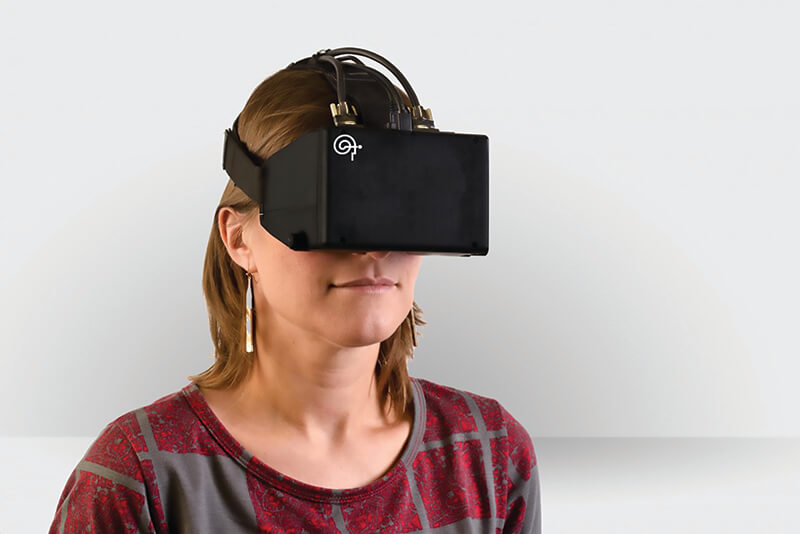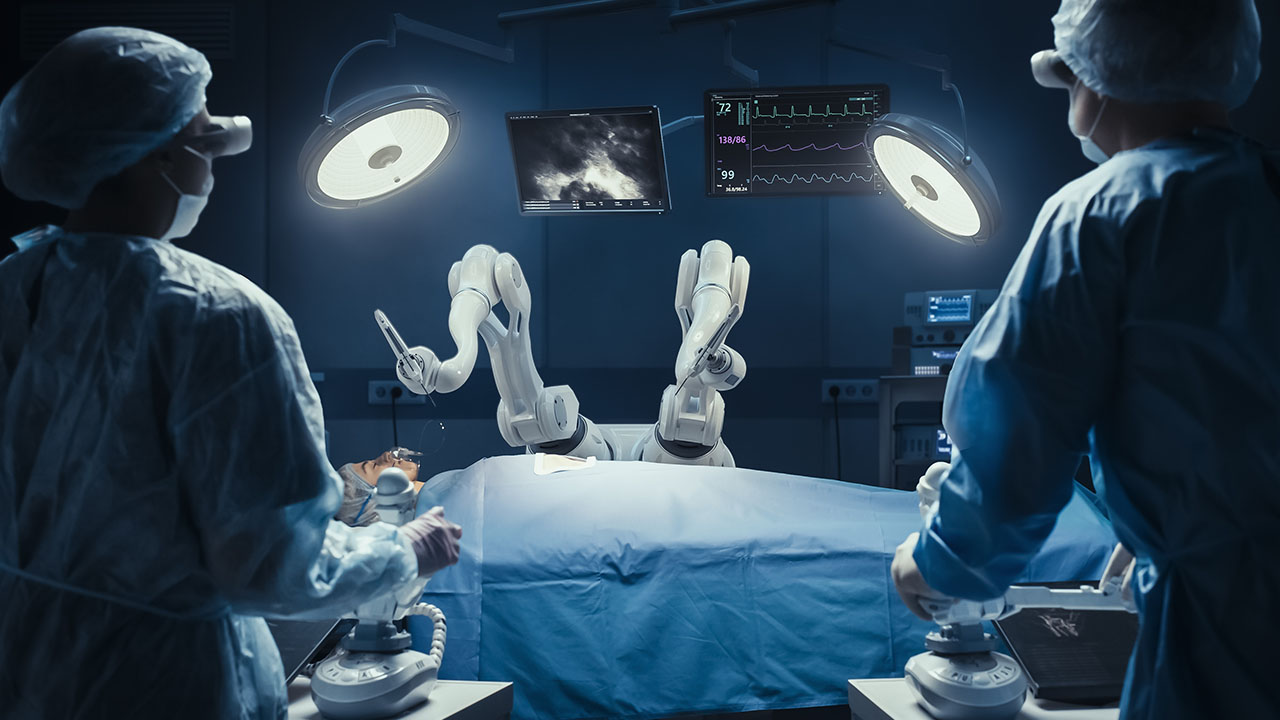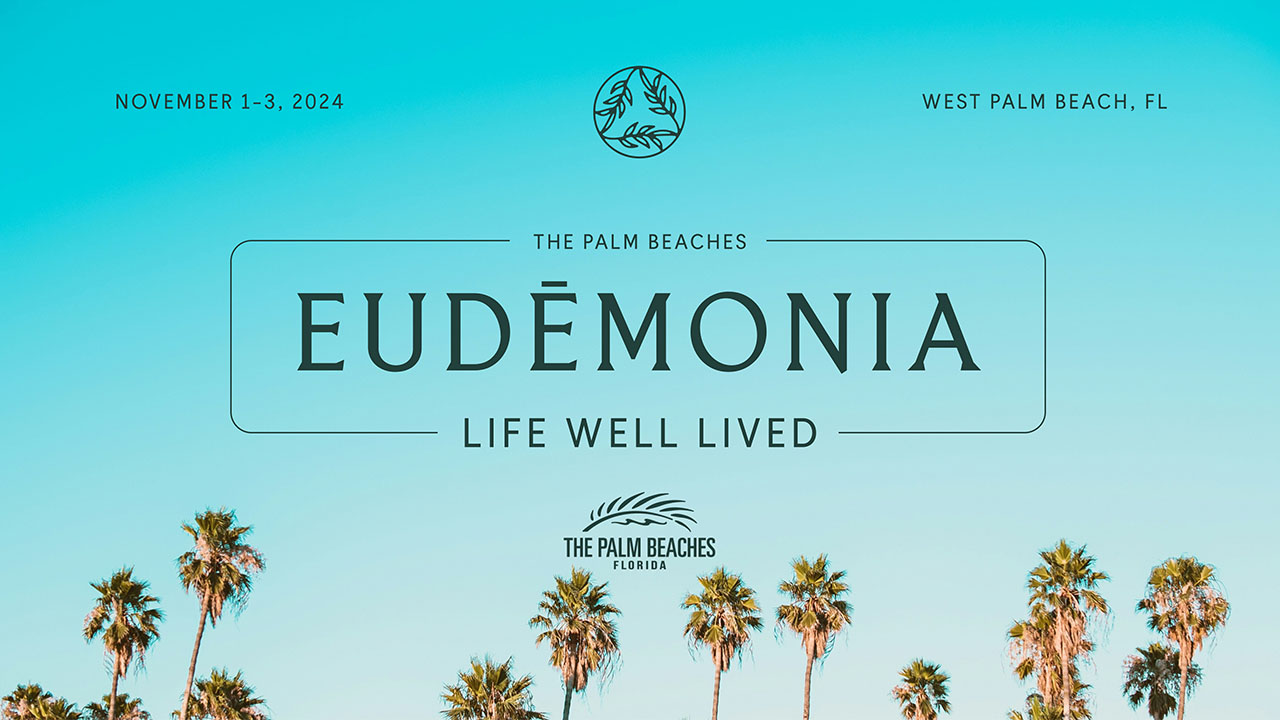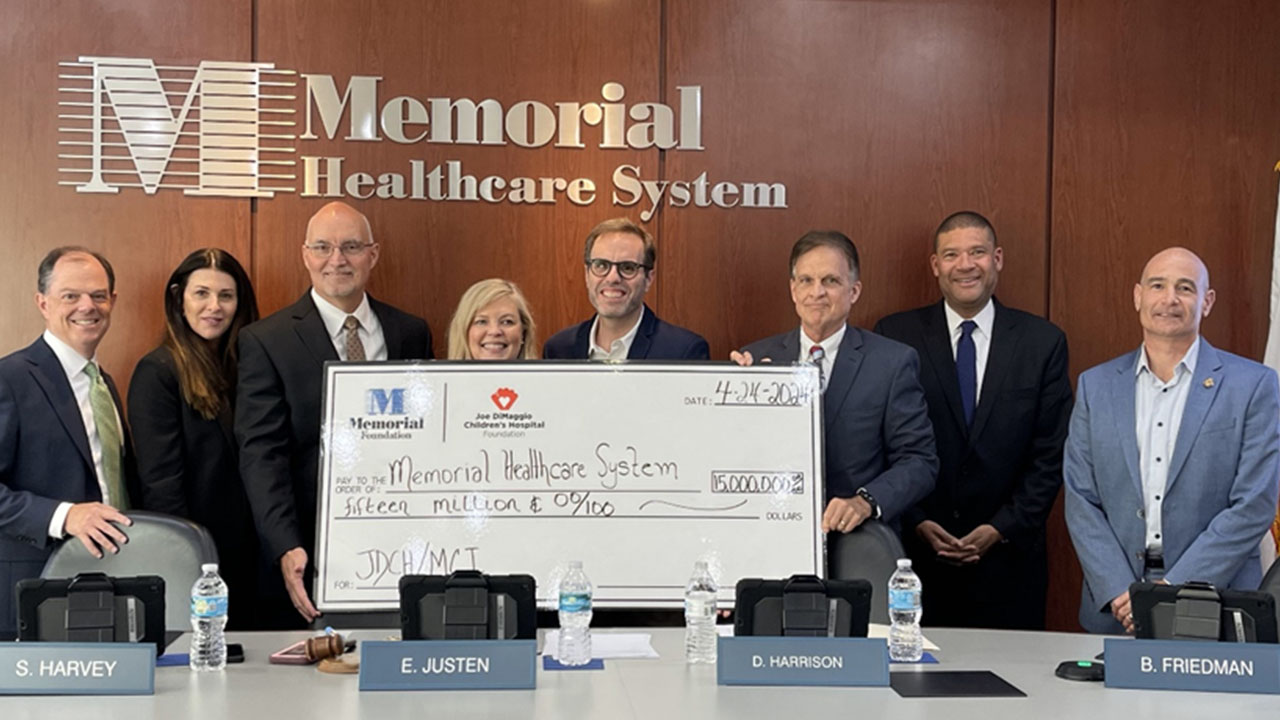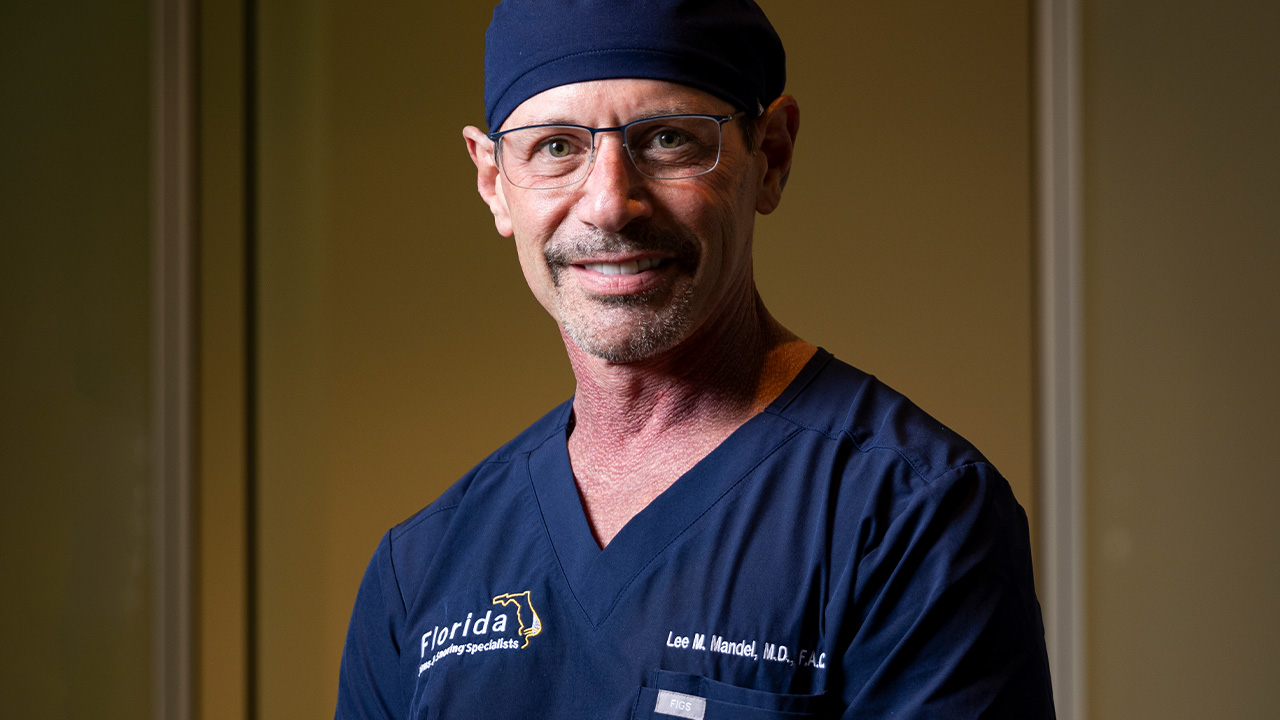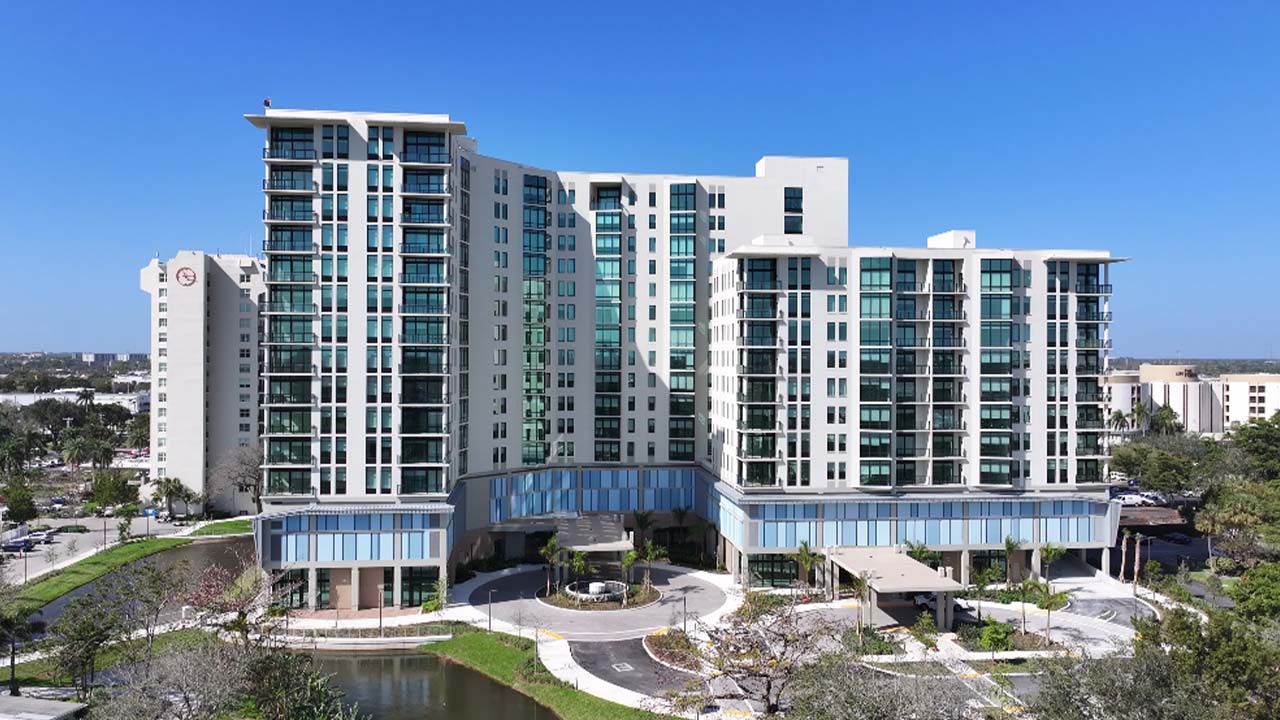Powered by American Stem Cell Centers of Excellence

By Martin Lenkowsky;with additional reporting by Sally-Ann O’Dowd
Using art to heal the sick and wounded, donning goggles to diagnose brain concussions, and a Palm Beach County hospital that wants patients to say “no to cheeseburgers,” are a few of the featured stories in this latest installment of SFBW’s series, “Innovations in Health Care.”
New tool diagnosing brain trauma
It’s familiar, troubling scene at football games: A dazed player is escorted off the field and tested for a concussion on the sideline. Fortunately, a new tool has been developed to assist the medical staff.
Michael Hoffer, an otolaryngologist at the University of Miami, helped research concussion goggles, made by Neuro Kinetics. Hoffer and others worked with the company on how to use the goggles for individuals with dizziness and other signs of head trauma.

The goggles are designed to do more than diagnose. “The goal is to be diagnostic as well as prognostic,” Hoffer says. “When can someone resume normal activities?”
The goggles, when paired with a laptop, can track an individual’s eye movement. Hoffer says the sooner a concussion is diagnosed, the more long-term consequences are reduced.
Memorial Mobility Team speeds up patient recovery
Memorial Healthcare’s Mobility Team not only gets patients moving for faster recovery, but to prevent injury to staffers.
“Patients who walk outside their room, leave the hospital a day and a half earlier,” says Maggie Hansen, Memorial’s senior vice president and chief nurse executive who oversees the Mobility program.
The team is composed of young professionals pursuing careers such as physical therapy and nursing, says Leslie Pollart, director of nursing at Memorial Regional Hospital South.
They are trained to use proper body mechanics and to use special lift equipment designed to help get patients out of bed.
There’s another advantage to having a mobility team. “A lot of nurses and physical therapists were getting hurt,” Hansen says. Memorial has seen a 77 percent decrease in musculoskeletal injuries to staff.
High-tech exercise equipment gives patients a lift
The new, state-of-the-art equipment recently acquired by Holy Cross Hospital’s Rehabilitation Department, through a generous donation, could not have come at a better time.
“We need to have the appropriate tools for the population. Twenty-five or 30 years ago, our patients were more active. They were still in shape. Today, they’re heavier and out of shape—less active,” says rehab manager Calimar Morales-Sanchez.
The Zero G machine allows input of a patient’s height and weight and has a harness that holds them. The system allows therapists to safely focus on improving a patient’s ambulation, with less risk of falling.
Another gait-training device is the Litegait, which also uses a harness to safely secure a patient. “It’s almost like a walker,” Morales-Sanchez says. “You can work on ambulation. Without it, you would usually need two physical therapists holding up the patient.”
Biodex works for patients with balance disorders. “It’s typically seen with Parkinson’s patients,” Morales-Sanchez says. “It’s almost designed as a game with a dot on the screen moving around so a patient can move their feet along with the dot. We have seen an improvement in gait and balance.”
Robotic-arm surgery gives knee surgery a boost
Surgeons at West Boca Medical Center are seeing positive outcomes by using Stryker’s Mako robotic-arm assisted technology when performing knee replacement surgery. The technique employs CT-based 3D modeling of bone anatomy to create a personalized surgical plan and identify the implant size, orientation and alignment based upon an individual’s anatomy.
“We can improve our accuracy with this instrument,” says orthopedic surgeon Curtis Kephart, who regularly uses the Mako technology. “The surgeon controls the resecting tool. It gives us real-time information in surgery. We can adjust the implant. With implants, you want everything balanced and straight. In the past, we just used our eyes.”
He’s been pleased with the results. “The outcomes have been excellent with the accuracy,” Kephart says. “There’s less pain and patients have been getting their motion back faster.”
The technology sometimes is used to treat hip fractures as well.
Fracture initiative is good news for the elderly
It wasn’t long ago that when an elderly person fell and broke a hip, a fatal bout of pneumonia often followed.
Baptist Health’s Miami Orthopedics and Sports Medicine Institute’s fragility fracture care initiative fights that problem.

“Fragility fractures are associated with low bone density,” says orthopedic surgeon Charles Jordan. He says fragility fractures are most common in the hips, lumbar spine, proximal humerus (shoulder joint), distal radius (forearm) and pelvis. He describes the initiative as an expedited level of care for patients—most often geriatric—coming through their emergency department with evidence of a fragility fracture.
The initiative expedites admission and surgery. “Surgeries are designed to get them walking right away,” Jordan says. “We need to get them out of bed quickly. We want them up and moving right away so they don’t pick up hospital-acquired infections or pneumonia.”
Jordan says he is now compiling data, but indications are the average hospital stay has been shortened by a day, and complications have gone down.
Stopping postoperative infections
We’ve all heard it: The operation was a success, but the patient died. Often, postoperative infections are the culprit.
Research is being done on ways to fight and prevent infections at Cleveland Clinic Florida’s Orthopedic and Rheumatology Center.

“Postsurgical complications, such as infections, are common,” says center director Carlos Higuera-Rueda, a board-certified orthopedic surgeon “It is projected that we will treat approximately 70,000 infections of hip [or] knee arthroplasty cases per year in 2020 in the United States. Infections in implants are very difficult to treat, and currently we are successful in treating only 60 to 70 percent of these cases.”
Higuera-Rueda says his organization is researching these infections using various approaches, including understanding bacterial resistance to antibiotics, the biofilm environment, and patients’ genetic predisposition to developing infections. Various strategies are being developed to combat and stop these infections.
“We are working on a unique nanosolution to disrupt biofilm, which is the main reason for the lack of success in treating infections,” Higuera-Rueda says. A biofilm is an aggregate of microorganisms in which cells are frequently embedded within self-produced substances and frequently adhere to each other and/or to a surface.
Hospital diet says no to all meats
Palm Beach County internist David Dodson was treating a patient who had just suffered a heart attack. He was making his rounds when he saw what was on the patient’s plate: a cheeseburger.
Dodson spoke with the nutritionist at West Palm Beach’s Good Samaritan Hospital, and together they came up with an alternative, plant-based menu. “It was time to say to patients, ‘If you change your eating habits, you won’t get a second heart attack.’ ”
Dodson, a vegan for at least six years, says other hospitals in the nation are also beginning to offer patients plant-based menus.
“Heart attacks, strokes and cancer would go down if Americans were eating a plant-based menu,” he says. “Animal meat sets off an inflammatory reaction and also increases the chance of getting cancer. The World Health Organization has declared red meat a [probable] human carcinogen, like tobacco and asbestos.”
Art can be the best medicine
Art—in all its forms—is the perfect medicine to heal and soothe wounds and bring joy to those most in need.
Jaye Abbate is president and CEO of ArtServe, a not-for-profit organization that helps artists and cultural organizations turn their art and passion into a viable profession. She says there are endless ways art can be used to heal. She cites as one striking example an exhibit by child survivors of a tsunami.
“They were so traumatized by seeing their parents, siblings and houses washed away that they literally could not speak,” she says. “Art therapists worked with these children to depict what they saw, and how they felt through drawings. Eventually, they were able to describe in more detail what their drawings revealed, helping them to process and cope with the tragedy.”

ArtServe recently completed a workshop with acclaimed local artist David “Lebo” Le Batard, in which “he helped veterans share their stories and process their trauma by working with them to create a collective art piece,” she says, adding that by the end the participants were crying and hugging. “One veteran even described it as a lifesaver.”
Abbate says when Holy Cross Hospital built its women’s center, it designated an area to be an art gallery where ArtServe coordinates rotating exhibitions. She says the gallery calms people down when they’re either visiting patients or going for treatment. Holy Cross Hospital CEO and President Patrick Taylor says, “We are proud to partner with ArtServe and sponsor an art exhibition that mirrors the mission of Holy Cross Hospital—supporting the overall emotional, mental and physical health of our community.”
Cancer survival rates improving with stem cell therapy
Since the Moffitt Cancer Center at Memorial Hospital West in Pembroke Pines opened its doors in July 2017, 60 stem cell transplants have been performed with a high survival rate, says physician Hugo Fernandez, chair and medical director of the Moffitt Malignant Hematology and Cellular Therapy Program.

“It’s a great situation to be in,” Fernandez says, adding that without these transplants many of these same patients’ chances of long-term survival would have been slim.
The program at Memorial West is a partnership between the highly regarded Moffitt Cancer Center in Tampa and Memorial Healthcare System, allowing blood cancer patients to receive high-quality care in South Florida. The clinic performs two types of stem cell transplants: autologous, when an individual’s own stem cells are used, and allogenic, where stem cells are harvested from a donor.

And what determines the type of treatment a patient receives? “A lot is based on the disease and the disease state,” Fernandez says. A patient’s risk of relapse is considered as well. Fernandez says in cases of leukemia other donors are used. “There’s also an immunological effect,” he says. With myeloma a person’s own cells are used.
Before stem cell transplants are performed, a patient is treated with chemotherapy.
MRIs and radiation: a cancer treatment trend
Baptist Health South Florida’s Miami Cancer Institute is the second medical center in the nation to use magnetic resonance image-guided therapy, also called MR Linac, says Michael Chuong, a radiation oncologist at the institute.

Chuong describes MR Linac as a hybrid between an MRI and radiation therapy. This technology provides a unique combination of continuous MRI and simultaneous radiation therapy delivery in cancer treatment.
“One hundred percent of the time, we’re monitoring within the body,” Chuong says. “This has never been done before. We can actually account for changes in a patient’s positioning. For example, a patient’s lung moves when they’re breathing. We can turn on the radiation only when the tumor is in the right position.”
MR Linac was recently approved by the Food and Drug Administration, Chuong says. It enhances the visibility of a cancerous tumor, and is especially effective in tumors of the liver, pancreas, lungs, head and neck.
It allows doctors to avoid radiating healthy tissues and organs, and to direct higher doses of radiation on a tumor itself, Chuong says.
Protein-rich plasma can promote healing
Although platelet-rich protein therapy wasn’t widely known to average folks until notable sports stars—including former New York Giants wide receiver Victor Cruz—began receiving it following an injury, it actually has been around for quite a while.
“It’s been around for probably 25 years,” says physician Thomas Best, a professor of orthopedics at the University of Miami’s Sports Medicine Institute. “It probably started in the dental field. It’s been in the orthopedic sports world about 15 years or so.”
Platelets are obtained from a patient’s own blood, which is spun in a centrifuge. “The platelets are left,” Best says, adding that platelets have within them “growth factors” that promote healing. “You can ‘jumpstart’ tissue with growth factor,” he says. “It definitely works in certain cases. We don’t know who’s going to get better or who is not. It may be genetic.”

He said PRP is being used now, but usually for soft-tissue injuries. “Some use it in the operating room,” he says.
Best says no widely accepted standards for PRP therapy have been established, and “that’s where lab studies are starting to pay off.”
“I think, in the future, we’ll really be looking at the growth factors,” he says. Best says more work needs to be done in this field. “I think it’s beyond promising. Data shows it works, but why? Also, what are the best indications?”
New treatment for stroke in development
Three is better than one. That’s the thinking behind an approach to treating strokes being studied by researchers at Florida Atlantic University’s Charles E. Schmidt College of Medicine.
One of the researchers, Jang-Yen Wu, says: “There is currently no treatment for strokes. The best treatment we now have for ischemia is TPA [tissue plasminogen activator]. TPA is used to break down blood clots.
“Our approach is quite different,” Wu says. “We use a three-drug combo, each with different mechanisms.”
Wu says reduced doses of each drug are given when they’re combined, to lessen any harmful side effects. One is used to overcome brain “overexcitation” that happens with a stroke. Another protects the brain’s neurons and can regenerate brain cells. That particular drug has also been useful for treating Parkinson’s disease. The third drug is an anti-inflammatory.
This new medical regimen has not yet been tested on patients, but researchers say they will be safe to use. “When combined together, it will decrease side effects each one separately might have,” says Howard Prentice, a professor of biomedical science in FAU’s medical college. “All three have been used for different applications.”
The researchers have joined forces on this project with CHS Pharma, a South Florida-based biotechnology company.
Like Priceline, but for health care
The number of self-paying patients, and those with sky-high insurance deductibles, is on the rise. That’s where a new Fort-Lauderdale-based company called MediXall enters the picture.
The company’s president, Michael Swartz, recognized this growing trend of self-paying patients, and those who are underinsured, who seek good-quality medical care at an affordable cost. He created an convenient way for them to shop for affordable, convenient medical care. “It works like Priceline, but for medical care,” he says.

MediXall has designed a platform for both patients and medical providers to find each other.
“It’s free for the consumer,” Swartz says. “Their only cost is what they have to pay the medical provider.”
Customers sign in to the MediXall website and indicate the services they’re seeking to receive and when. Medical providers who have signed up with the service can view these potential patients and the services they need.
Patients can see where the doctor is located, plus the actual amount they’ll be paying. “It’s transparent for consumers,” Swartz says. “It’s designed in a way to benefit cash-pay customers.” As for their providers, “We’re a risk-free patient acquisition provider,” he says. “It’s no cost to them.”
Swartz says medical providers joining up with MediXall are screened. Before patients select a physician, they have an opportunity to review that doctor’s ratings, reviews and medical training.
Swartz says MediXall started with a controlled launch in South Florida, but plans are underway to expand. Swartz says MediXall recently partnered with CoreChoice, a nationwide radiology network with 22,000 imaging facilities.
Teaching the brain to improve
There are better—and more accurate—ways of diagnosing concussions and other types of brain and neurological dysfunction than the traditional methods used by the medical community, says David Traster, a chiropractic neurologist and co-founder of South Florida Integrative Health, which recently debuted in Miami.
Traster’s practice uses neuroplasticity, an approach that involves the ability of the brain and spinal cord to change and reorganize themselves. Research shows that so-called “brain remodeling” can take place at any age or scale.
Traster says the two most common impairments he sees are concussions and children with attention or learning disorders.
“We look at all areas of the brain,” Traster says. “We have a lot of advanced technology that looks at function. We tailor our rehab to that injured area.” Likewise, he says, similar assessments of function are made in cases of learning disabilities and other neurological dysfunctions.
“We can localize where the injury is and do therapies for that area,” he says.
A harrowing account of a childhood stroke
When 11-year-old Lynn-sah Joseph, of Coral Springs, woke up the Monday before last Thanksgiving, she wasn’t feeling well and threw up. Having had a history of stomach problems, neither she nor her parents thought much of it. She headed off to Forest Glen Middle School.
Her condition worsened throughout the day, and the school nurse called her mother, Edgire Joseph, to say Lynn-sah was complaining of dizziness and a headache. By afternoon, she was at home vomiting again. She almost fell on the way to the bathroom.
After returning home from work, Joseph called 911. The emergency teams diagnosis? Lynn-sah had suffered a stroke.

By the time they reached Fort Lauderdale’s Broward Health Medical Center for specialized care, she was paralyzed on her left side. Interventional neurologist Celso Agner immediately came to the hospital.
Agner guided a stent retriever through a major artery toward a large clot in the right-center of her brain. With the device’s mesh-like end, he trapped and pulled out the clot in one pass. This procedure is not approved for children; in fact, there are no protocols for treating strokes in young people because there are not enough test subjects for clinical trials. “If you only use what the trials allow, she’d be in a completely different spot. But I’m straight-to-the-point, and [I] get to the root of the problem,” Agner says.
Six days after her surgery, Lynn-sah’s neurological tests indicated normal results. After another six weeks of physical and occupational therapy to correct the residual weakness in her left arm, she was ready to go back to school. While 50 to 80 percent of child stroke survivors have some type of permanent disabilities, according to the American Stroke Association, she is getting better grades on weekly reading tests. “It’s like the surgery triggered a part of my brain that made me smarter,” she says. ♦



